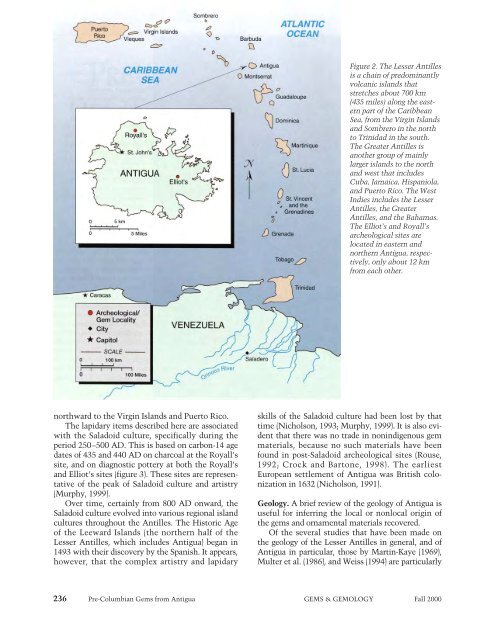Fall 2000 Gems & Gemology - Gemfrance
Fall 2000 Gems & Gemology - Gemfrance
Fall 2000 Gems & Gemology - Gemfrance
You also want an ePaper? Increase the reach of your titles
YUMPU automatically turns print PDFs into web optimized ePapers that Google loves.
northward to the Virgin Islands and Puerto Rico.<br />
The lapidary items described here are associated<br />
with the Saladoid culture, specifically during the<br />
period 250–500 AD. This is based on carbon-14 age<br />
dates of 435 and 440 AD on charcoal at the Royall’s<br />
site, and on diagnostic pottery at both the Royall’s<br />
and Elliot’s sites (figure 3). These sites are representative<br />
of the peak of Saladoid culture and artistry<br />
(Murphy, 1999).<br />
Over time, certainly from 800 AD onward, the<br />
Saladoid culture evolved into various regional island<br />
cultures throughout the Antilles. The Historic Age<br />
of the Leeward Islands (the northern half of the<br />
Lesser Antilles, which includes Antigua) began in<br />
1493 with their discovery by the Spanish. It appears,<br />
however, that the complex artistry and lapidary<br />
Figure 2. The Lesser Antilles<br />
is a chain of predominantly<br />
volcanic islands that<br />
stretches about 700 km<br />
(435 miles) along the eastern<br />
part of the Caribbean<br />
Sea, from the Virgin Islands<br />
and Sombrero in the north<br />
to Trinidad in the south.<br />
The Greater Antilles is<br />
another group of mainly<br />
larger islands to the north<br />
and west that includes<br />
Cuba, Jamaica, Hispaniola,<br />
and Puerto Rico. The West<br />
Indies includes the Lesser<br />
Antilles, the Greater<br />
Antilles, and the Bahamas.<br />
The Elliot’s and Royall’s<br />
archeological sites are<br />
located in eastern and<br />
northern Antigua, respectively,<br />
only about 12 km<br />
from each other.<br />
skills of the Saladoid culture had been lost by that<br />
time (Nicholson, 1993; Murphy, 1999). It is also evident<br />
that there was no trade in nonindigenous gem<br />
materials, because no such materials have been<br />
found in post-Saladoid archeological sites (Rouse,<br />
1992; Crock and Bartone, 1998). The earliest<br />
European settlement of Antigua was British colonization<br />
in 1632 (Nicholson, 1991).<br />
Geology. A brief review of the geology of Antigua is<br />
useful for inferring the local or nonlocal origin of<br />
the gems and ornamental materials recovered.<br />
Of the several studies that have been made on<br />
the geology of the Lesser Antilles in general, and of<br />
Antigua in particular, those by Martin-Kaye (1969),<br />
Multer et al. (1986), and Weiss (1994) are particularly<br />
236 Pre-Columbian <strong>Gems</strong> from Antigua GEMS & GEMOLOGY <strong>Fall</strong> <strong>2000</strong>


